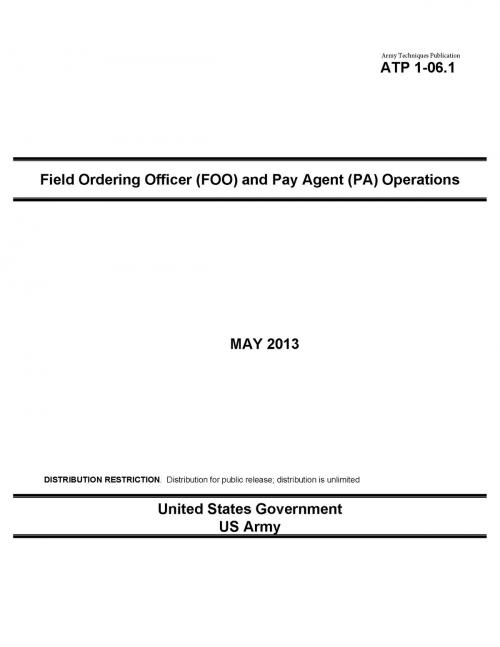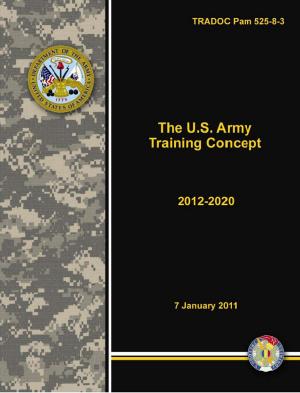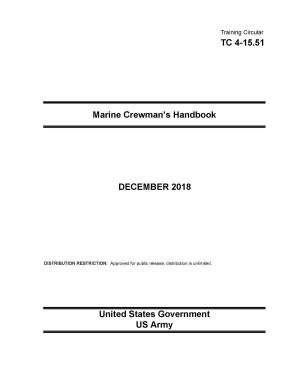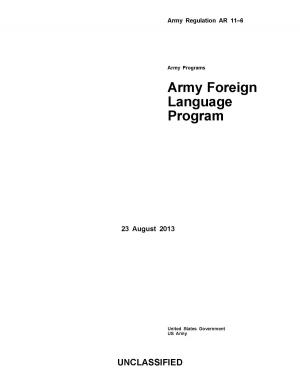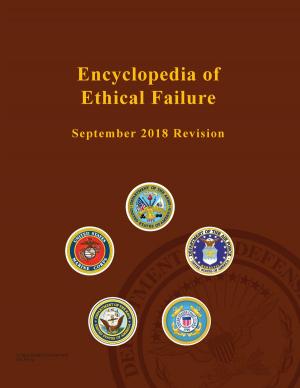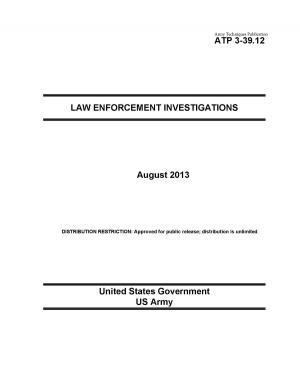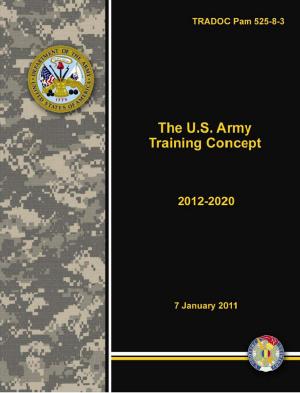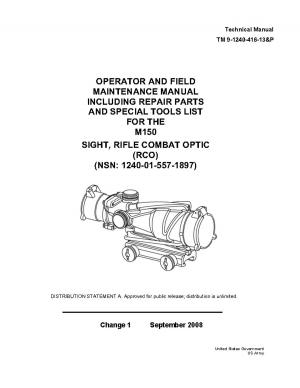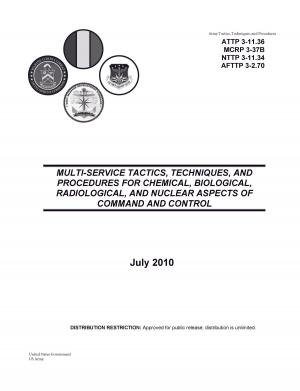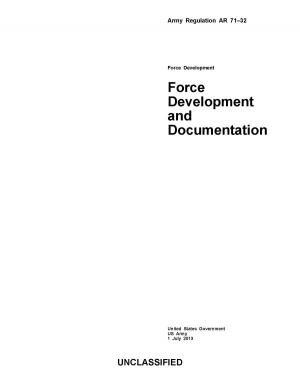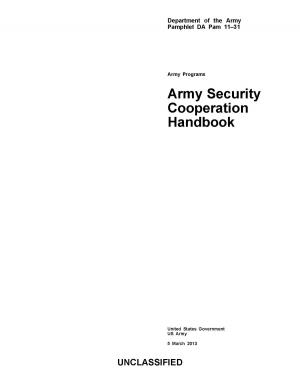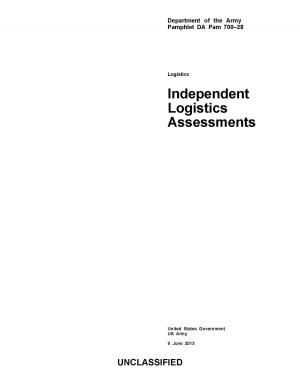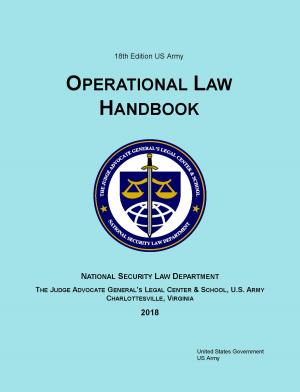Army Techniques Publication ATP 1-06.1 Field Ordering Officer (FOO) and Pay Agent (PA) Operations May 2013
Nonfiction, Reference & Language, Study Aids, Graduate & Professional, Armed Forces, Science & Nature, Technology, Military Science, Reference, Guides & Handbooks| Author: | United States Government US Army | ISBN: | 1230000136163 |
| Publisher: | eBook Publishing Team | Publication: | May 27, 2013 |
| Imprint: | Language: | English |
| Author: | United States Government US Army |
| ISBN: | 1230000136163 |
| Publisher: | eBook Publishing Team |
| Publication: | May 27, 2013 |
| Imprint: | |
| Language: | English |
This Army Techniques Publication (ATP) provides doctrinal guidance and procedures required for personnel who are appointed to perform duties as pay agents (PAs) and field ordering officers (FOOs).
ATP 1-06.1 has five chapters and one appendix. Chapter 1 describes participants in the micro-purchase process and provides an overview of this process. This chapter allows the FOO/PA team to understand their interaction with other members, where they belong in the process, why their duties are unique, and when in the process they will execute their duties. Chapter 2 outlines the duties and responsibilities that are specific to the FOOs position and provides select excerpts from the Army Federal Acquisition Regulation Supplement (AFARS). Chapter 3 provides specific procedures required of the FOO during a purchase. Chapters 4 and 5 provide the same type of information required of the PA in accordance with (IAW) the DoD 7000.14-R, Department of Defense Financial Management Regulations (FMRs), Volume 5. The appendix provides sample forms and documents that visually assist the FOO/PA team in completing required documentation.
ATP 1-06.1 was developed to expand on FM 1-06, Financial Management Operations, Chapter 3, Banking and Disbursing. It also expands on the previously published Center for Army Lessons Learned (CALL) Handbook 09-16, Field Ordering Officer and Paying Agent Handbook (July 2009) and CALL Handbook 10-39, Unit Commander’s Guide to Paying Agents Handbook (April 2010).
ATP 1-06.1 applies to all Army components across the operating and generating force, and during all levels of military operations.
The proponent for this manual is the U.S. Army Training and Doctrine Command (TRADOC) and the preparing agent is the U.S. Army Soldier Support Institute (SSI).
The current Army structure combined with the increased demands of full spectrum operations has placed an enormous demand on the Army’s logistics capabilities. In response to this, commanders have increasingly needed to employ other means of acquiring goods or services necessary for accomplishment of the mission. One of these means is through the use of a FOO/PA team that facilitates the micro-purchase process.
Since the American Revolution, vendors have been part of the battlefield in some form or another. General George Washington used civilian wagon drivers to haul military supplies. Vendors supported military operations during the American Civil War, both World Wars, the Vietnam War, and the Persian Gulf War. Over time, vendor support evolved from an ad hoc, add-on capability to an essential, vital part of force projection capability.
The Army relies on contracts for equipment, supplies, and services. Most contracts are not million or multi- million-dollar programs that receive multiple levels of review; they are usually small micro-purchases that units use to meet one-time, immediate needs. The basic standards of ethics and business practices for large programs also apply to micro-purchases.
Successful operational contract support (OCS) requires all personnel involved in the process to not only understand their specific role in the process, but to be familiar with the specific rules, policies, and procedures required in the execution of their duties and responsibilities. This includes custody and proper disposition of government funds entrusted to them.
Unit commanders establish and use FOOs and PAs to make over-the-counter purchases in amounts up to the micro-purchase threshold. The FOO/PA team provides the unit commander with the ability to make local purchases quickly and directly to support the unit commander’s mission. As such, unit commanders will select highly capable individuals for duty as FOOs and PAs and will ensure other duties assigned to a FOO or PA do not conflict with or delay the performance of their appointed duties.
This Army Techniques Publication (ATP) provides doctrinal guidance and procedures required for personnel who are appointed to perform duties as pay agents (PAs) and field ordering officers (FOOs).
ATP 1-06.1 has five chapters and one appendix. Chapter 1 describes participants in the micro-purchase process and provides an overview of this process. This chapter allows the FOO/PA team to understand their interaction with other members, where they belong in the process, why their duties are unique, and when in the process they will execute their duties. Chapter 2 outlines the duties and responsibilities that are specific to the FOOs position and provides select excerpts from the Army Federal Acquisition Regulation Supplement (AFARS). Chapter 3 provides specific procedures required of the FOO during a purchase. Chapters 4 and 5 provide the same type of information required of the PA in accordance with (IAW) the DoD 7000.14-R, Department of Defense Financial Management Regulations (FMRs), Volume 5. The appendix provides sample forms and documents that visually assist the FOO/PA team in completing required documentation.
ATP 1-06.1 was developed to expand on FM 1-06, Financial Management Operations, Chapter 3, Banking and Disbursing. It also expands on the previously published Center for Army Lessons Learned (CALL) Handbook 09-16, Field Ordering Officer and Paying Agent Handbook (July 2009) and CALL Handbook 10-39, Unit Commander’s Guide to Paying Agents Handbook (April 2010).
ATP 1-06.1 applies to all Army components across the operating and generating force, and during all levels of military operations.
The proponent for this manual is the U.S. Army Training and Doctrine Command (TRADOC) and the preparing agent is the U.S. Army Soldier Support Institute (SSI).
The current Army structure combined with the increased demands of full spectrum operations has placed an enormous demand on the Army’s logistics capabilities. In response to this, commanders have increasingly needed to employ other means of acquiring goods or services necessary for accomplishment of the mission. One of these means is through the use of a FOO/PA team that facilitates the micro-purchase process.
Since the American Revolution, vendors have been part of the battlefield in some form or another. General George Washington used civilian wagon drivers to haul military supplies. Vendors supported military operations during the American Civil War, both World Wars, the Vietnam War, and the Persian Gulf War. Over time, vendor support evolved from an ad hoc, add-on capability to an essential, vital part of force projection capability.
The Army relies on contracts for equipment, supplies, and services. Most contracts are not million or multi- million-dollar programs that receive multiple levels of review; they are usually small micro-purchases that units use to meet one-time, immediate needs. The basic standards of ethics and business practices for large programs also apply to micro-purchases.
Successful operational contract support (OCS) requires all personnel involved in the process to not only understand their specific role in the process, but to be familiar with the specific rules, policies, and procedures required in the execution of their duties and responsibilities. This includes custody and proper disposition of government funds entrusted to them.
Unit commanders establish and use FOOs and PAs to make over-the-counter purchases in amounts up to the micro-purchase threshold. The FOO/PA team provides the unit commander with the ability to make local purchases quickly and directly to support the unit commander’s mission. As such, unit commanders will select highly capable individuals for duty as FOOs and PAs and will ensure other duties assigned to a FOO or PA do not conflict with or delay the performance of their appointed duties.
